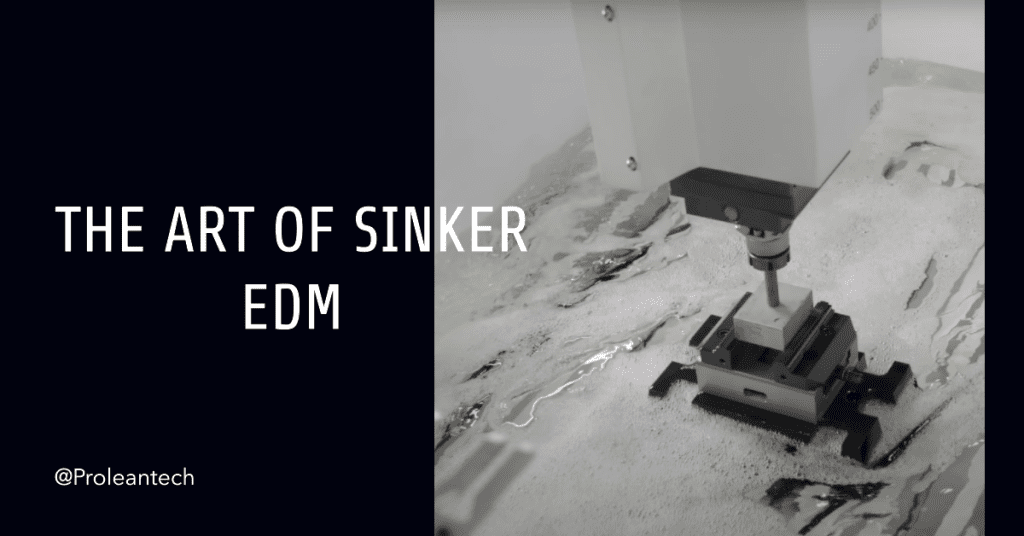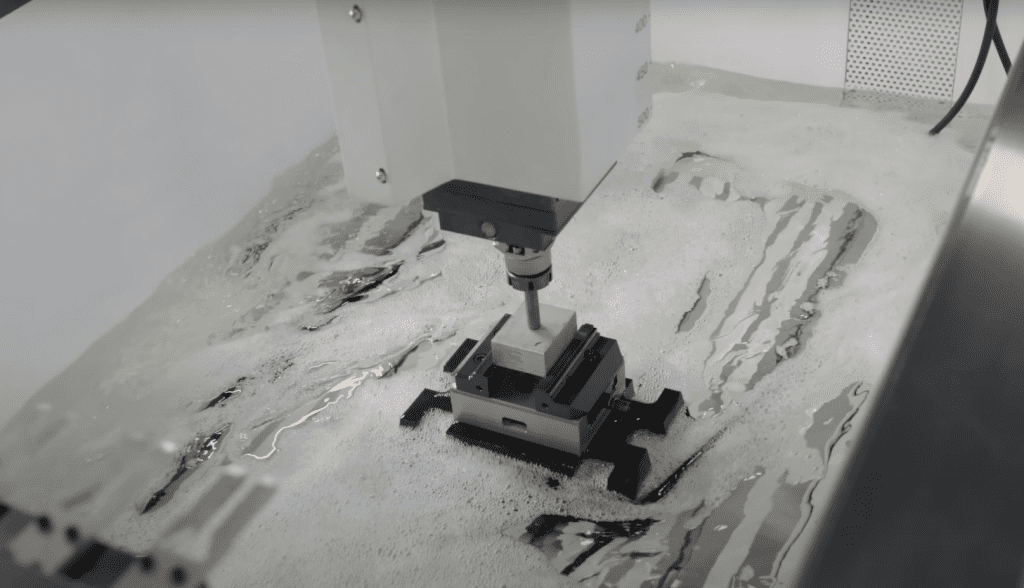
Sinker EDM, also known as sink EDM or cavity-type EDM, is an essential manufacturing process in modern industry. It is a non-conventional machining technique that uses electrical discharge to remove material from a workpiece, creating intricate shapes and designs. Sinker EDM is a versatile method that can be employed to create complex geometries in a wide range of materials.
This article aims to provide a comprehensive guide to mastering sinker EDM techniques, from understanding the process to learning about its applications in various industries.
Understanding the Sinker EDM Process

Sinker EDM setup
The sinker EDM process begins with designing the desired shape or geometry on computer-aided design (CAD) software. This design is then converted into a 3D model, which serves as a blueprint for the EDM machine. The workpiece is submerged in a dielectric fluid, which serves as an insulator and coolant during the machining process. An electrode, typically made of graphite, copper, or copper-tungsten, is designed to match the desired shape of the final workpiece.
The electrode is then submerged in the dielectric fluid and connected to a power source, creating an electrical discharge between the electrode and the workpiece. The electrical discharge erodes the workpiece material, cutting away unwanted material and leaving behind the desired shape. The dielectric fluid is continuously circulated to remove debris and maintain a stable environment for the electrical discharge.
One significant advantage of the sinker EDM process is its ability to machine hard materials and create intricate shapes without requiring excessive force. This makes it ideal for manufacturing components with tight tolerances and complex geometries, such as aerospace and automotive parts, molds, dies, and medical devices.
Related to: Electrical Discharge Machining: An Essential Beginner’s Guide
Components of a Sinker EDM Machine
A sinker EDM machine consists of several essential components that work together to ensure a precise and efficient machining process. These components include:
| Component | Description |
|---|---|
| Power supply | Provides the electrical energy required for the EDM process. Controls the voltage, current, and pulse duration to achieve the desired material removal rate and surface finish. |
| Electrode | The conductive material used to create the electrical discharge. Can be made of various materials, such as graphite, copper, or copper-tungsten, depending on the specific requirements of the EDM process. |
| Dielectric fluid | An insulating liquid used to immerse the workpiece and electrode during the machining process. Maintains a stable environment for the electrical discharge, cools the workpiece and electrode, and flushes away debris from the machining area. |
| Workpiece holder | Secures the workpiece in place during the EDM process. Ensures proper alignment and stability of the workpiece, contributing to the overall accuracy and precision of the machining process. |
| CNC controller | The computerized system that controls the movement and positioning of the electrode and workpiece during the EDM process. Interprets the CAD design and 3D model, translating it into precise machine movements for accurate material removal. |
| Filtration system | Responsible for continuously circulating the dielectric fluid, removing debris and contaminants, and maintaining the optimal conditions for the EDM process. |
The Art of Mastering Sinker EDM: Key Tips and Tricks
Mastering sinker EDM techniques require a thorough understanding of the process and its variables, as well as extensive hands-on experience. Here are some key tips and tricks to help you become a proficient sinker EDM machinist:
Proper electrode selection: Choosing the right electrode material and design is crucial for efficient material removal and achieving the desired surface finish. Factors such as workpiece material, machining depth, and complexity of the geometry should be considered when selecting the electrode.
Optimal power settings: Adjusting the power supply settings, such as voltage, current, and pulse duration, can significantly impact the material removal rate, surface finish, and overall machining efficiency. Experiment with different power settings to find the optimal balance for each specific application.
Maintain dielectric fluid quality: Regularly monitoring and maintaining the dielectric fluid’s quality is essential for a stable and efficient EDM process. Ensure that the fluid is adequately circulated, filtered, and free of contaminants to minimize any potential issues during machining.
Precise workpiece and electrode alignment: Accurate alignment of the workpiece and electrode is critical for achieving the desired shape and tolerances. Use appropriate work-holding fixtures and regularly verify the positioning to ensure consistent results.
Monitor and optimize process variables: Continuously monitoring variables such as electrode wear, material removal rate, and surface finish can help identify areas for improvement and optimization. Implementing real-time feedback and adaptive control systems can further enhance the overall efficiency of the sinker EDM process.
Try Prolean Now!
Materials Suitable for Sinker EDM
Sinker EDM is a versatile machining process capable of working with a wide range of materials, including:
| Material | Description | Examples |
|---|---|---|
| Metals | Hard metals that are difficult to machine using conventional methods | Titanium, tungsten carbide, tool steels |
| Conductive ceramics | Advanced ceramics with conductive properties | Silicon carbide, silicon nitride |
| Composites | Conductive composite materials | Metal matrix composites (MMCs), carbon fiber reinforced polymers (CFRPs) |
| Superalloys | High-temperature and corrosive-resistant alloys | Inconel, Hastelloy |
It is important to note that sinker EDM is only suitable for electrically conductive materials. Non-conductive materials, such as plastics and non-metallic ceramics, cannot be machined using this process.
Read more: Materials Suitable for EDM Process
Applications of Sinker EDM in Various Industries

Wire EDM machined parts
Sinker EDM is widely used in various industries due to its versatility and precision. Here are some of the industries and applications that frequently employ sinker EDM:
| Industry | Applications | Examples |
|---|---|---|
| Aerospace | Manufacture complex components for aircraft engines, such as turbine blades and vanes. Produce airfoil shapes in wing structures. | Turbine blades, vanes, airfoil shapes |
| Medical | Manufacture medical implants, such as orthopedic implants and dental prosthetics. Create surgical instruments with intricate geometries. | Orthopedic implants, dental prosthetics, surgical instruments |
| Automotive | Manufacture molds for automotive parts, such as gears and bearings. Create engine components with complex geometries, such as fuel injectors and valves. | Molds for gears and bearings, fuel injectors, valves |
| Tool and die | Produce molds and dies for various industries, such as plastics, rubber, and metal stamping. Create precision cutting tools with complex geometries, such as drills and end mills. | Molds and dies for plastics, rubber, metal stamping, precision cutting tools |
| Electronics | Manufacture components for electronic devices, such as connectors and sensors. Produce precision molds for plastic injection molding of electronic parts. | Connectors, sensors, precision molds for plastic injection molding |
Sinker EDM vs. Wire EDM: A Comparison
Sinker EDM and wire EDM are both non-conventional machining techniques that use electrical discharge to remove material from a workpiece. However, there are some significant differences between the two methods. Here is a comparison between sinker EDM vs. wire EDM:
- Electrode type: Sinker EDM uses a shaped electrode, while wire EDM uses a thin wire as the electrode.
- Workpiece thickness: Sinker EDM can machine thick workpieces, while wire EDM is typically better suited for thinner materials.
- Taper angle: Sinker EDM can produce tapered shapes, while wire EDM cannot.
- Surface finish: Sinker EDM typically produces a rougher surface finish than wire EDM.
- Cost: Sinker EDM is generally more expensive than wire EDM due to the need for shaped electrodes and dielectric fluid.
Comparison Table
| Electrode type | Workpiece thickness | Taper angle | Surface finish | Cost |
|---|---|---|---|---|
| Shaped electrode (Sinker EDM) | Can machine thick workpieces | Can produce tapered shapes | Typically produces a rougher surface finish than wire EDM | Generally more expensive due to the need for shaped electrodes and dielectric fluid |
| Thin wire (Wire EDM) | Typically better suited for thinner materials | Cannot produce tapered shapes | Typically produces a smoother surface finish than Sinker EDM | Generally less expensive than Sinker EDM due to simpler electrode requirements |
Both sinker EDM and wire EDM have their unique advantages and limitations, and the choice between the two methods depends on the specific requirements of the application.
Read more: Wire Cut VS EDM: Cost and Performance Analysis
Need Any EDM Services? Contact ProleanTech
If you are in need of professional EDM services, look no further than ProleanTech. Our team of experts has extensive experience in sinker EDM, wire EDM, and other non-conventional machining techniques. We use state-of-the-art equipment and advanced software to deliver high-quality components with tight tolerances and complex geometries. Contact us today to learn more about our services and how we can help you with your next manufacturing project.
Conclusion
Sinker EDM is an essential machining process that has revolutionized the manufacturing industry. It is a versatile technique that can be employed to create complex geometries in a wide range of materials. Mastering sinker EDM techniques require a thorough understanding of the process’s variables and extensive hands-on experience. This comprehensive guide has provided an overview of the sinker EDM process, the components of a sinker EDM machine, and mastery tips and tricks. It has also discussed the types of materials suitable for sinker EDM, their applications in various industries, and a comparison between sinker EDM vs. wire EDM. ProleanTech offers professional EDM machining services for all your manufacturing needs.
FAQs
What is sinker EDM?
Sinker EDM is a non-conventional machining technique that uses electrical discharge to remove material from a workpiece, creating intricate shapes and designs.
What materials are suitable for sinker EDM?
Sinker EDM can work with a wide range of electrically conductive materials, including metals, conductive ceramics, composites, and superalloys.
What are the components of a sinker EDM machine?
A sinker EDM machine consists of a power supply, electrode, dielectric fluid, workpiece holder, CNC controller, and filtration system.
What are some applications of sinker EDM?
Sinker EDM is used in various industries, including aerospace, medical, automotive, tool and die, and electronics, to manufacture complex components with tight tolerances and intricate geometries.
What is the difference between sinker EDM and wire EDM?
Sinker EDM uses a shaped electrode, can machine thicker workpieces, and can produce tapered shapes, while wire EDM uses a thin wire as the electrode, is better suited for thinner materials, and typically produces a smoother surface finish.




0 Comments